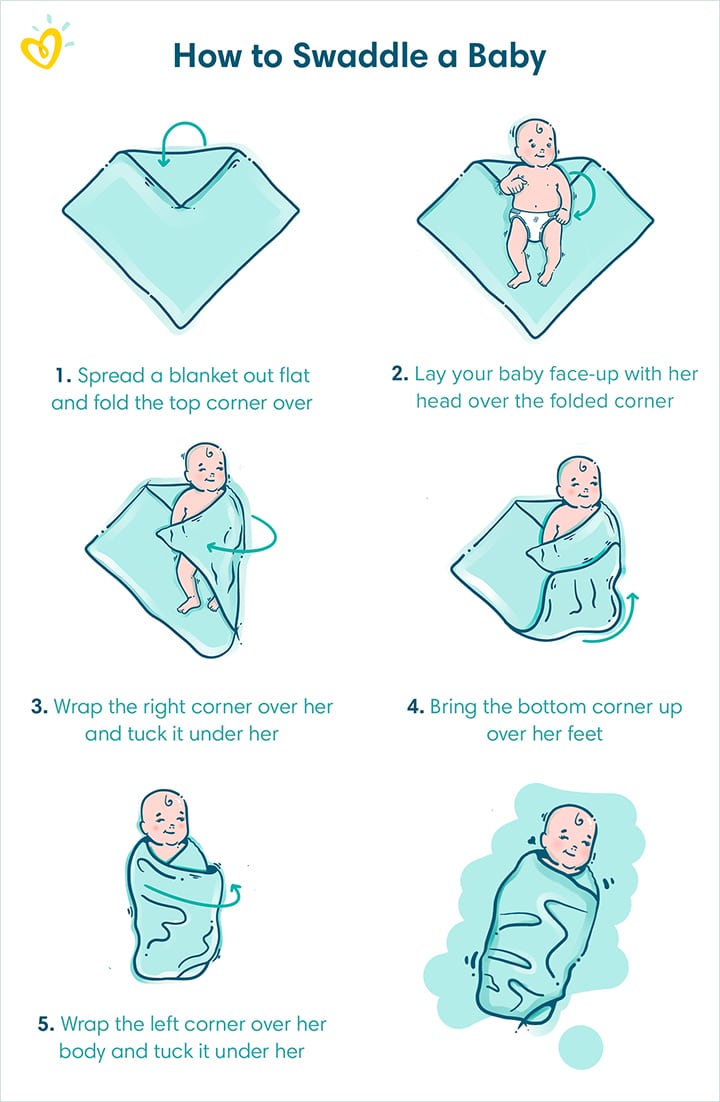The Five S’s baby sleep strategy was developed by Harvey Karp and features in his bestselling book “The Happiest Baby On The Block”. The strategy was developed specifically to soothe newborns who were crying although all of their physical needs were met. The steps aim to provide your baby with comfort by imitating the sensations they recognise from inside the womb.
These techniques can allow parents to have a happier and healthier Fourth Trimester. Crying babies trigger their parents’ fight or flight response, releasing adrenaline and cortisol into their body. Extended periods of stress can cause serious declines in parental mental health. This is why having reliable settling techniques is so important.
If you’ve been having trouble establishing a great settling technique, read on to see if the Five S’s could be exactly what you need.
1 – Swaddle
The aim of swaddling is to give your baby a sense of security. When they were in the womb, they didn’t have much space around them. Any spare space was filled with cosy amniotic fluid which insulated and comforted them. Suddenly they’re born into a world with endless empty space around them. The snug blanket helps to make the world feel less vast and cold.
Tips for a safe swaddle:
- Always choose the lightest blanket available to avoid overheating.
- Limit the number of layers your baby wears under their swaddle. Depending on the room temperature, your baby could just wear their nappy under the swaddle.
- Check that you can fit 2-3 fingers between your baby’s swaddle and their chest. This is snug but not too tight.
- Only swaddle as far as their collarbone. This gives them plenty of space to breathe. A swaddle should not come up to their chin or higher.
- Stop swaddling for sleep as soon as your baby shows signs of rolling over. A swaddled baby who rolls onto their front can find it hard to breathe.
- Don’t wrap their legs tightly to avoid any issues with their hips.
Check out this handy infographic from Pampers’ article “How to Swaddle Your Baby”

2- Side/stomach position
Babies should never be placed on their side or stomach for sleep. However, they can be held on their stomach or side whilst being held for extra comfort. You can lie your baby along your arm while supporting their head with your hand to soothe them. Or, you can place them on your chest.
Tips for safe side/stomach position:
- Always ensure your baby’s airways are not obstructed when holding them in different positions. Think of your baby’s airways as a plastic straw – nothing can pass through if it’s bent.
- Once your baby is settled or sleeping, place them on their back to sleep.
- If you feel like you could fall asleep, put your baby in their safe sleep space. Never sleep while holding your baby in any position as you risk dropping them.
- Take your time while trying to find a comfortable position that soothes your baby. If you’re feeling stressed you may be more likely to move your baby with jerky movements, which can inadvertently injure them.
3- Shush
Tell your baby to shush! When your baby was in the womb, they heard constant sounds from your body such as your blood circulating and your digestive system working. Inside the womb can be as loud as 96dB (about as loud as a lawnmower!) so your baby can be quite unsettled by silence.
To shush your baby, simply say “shhh” loudly for as long as you can, then take a deep breath, and “shhh” again! Start by matching the volume of their crying, then lower your volume as they start to calm down. This long, single-frequency sound is a great replacement for the noise they grew to love in the womb.

4- Swing
During your pregnancy, you may have noticed that your baby kicked much less when you were active. This is because they were soothed by the rocking created by your movements. Swinging your baby is as simple as holding them (paying special attention to supporting their head and neck) and swaying back and forth. Keep your movements small, smooth and gentle. Pay attention to any tension you may be holding in your body, tension can lead to jerky, shaky movements which are dangerous for your baby.
5-Sucking
Sucking is your baby’s strongest instinct and they’ve been perfecting it since week 14 of gestation. It helps them to feel safe and secure. This is why using a soother (pacifier, dummy, whatever you like to call it) is effective. Soothers also have the benefit of lowering your baby’s risk of SIDS.
Some parents avoid soothers as they’re concerned about nipple confusion interfering with breastfeeding. However, the concept of nipple confusion is widely debated. Babies may grow to prefer a bottle teet rather than their mother’s nipple because the bottle’s flow is constant and quick, whereas their mother’s nipple can be more intermittent and slower. A soother is a form of non-nutritive sucking (not for nutrition) so it’s unlikely to ever be preferred in comparison to actual feeding.
Nothing seems to soothe your baby?
If your baby continues to cry regardless of what you do, you should see your GP to rule out any medical causes for their crying. If your baby is perfectly healthy, they may be diagnosed with Colic.







